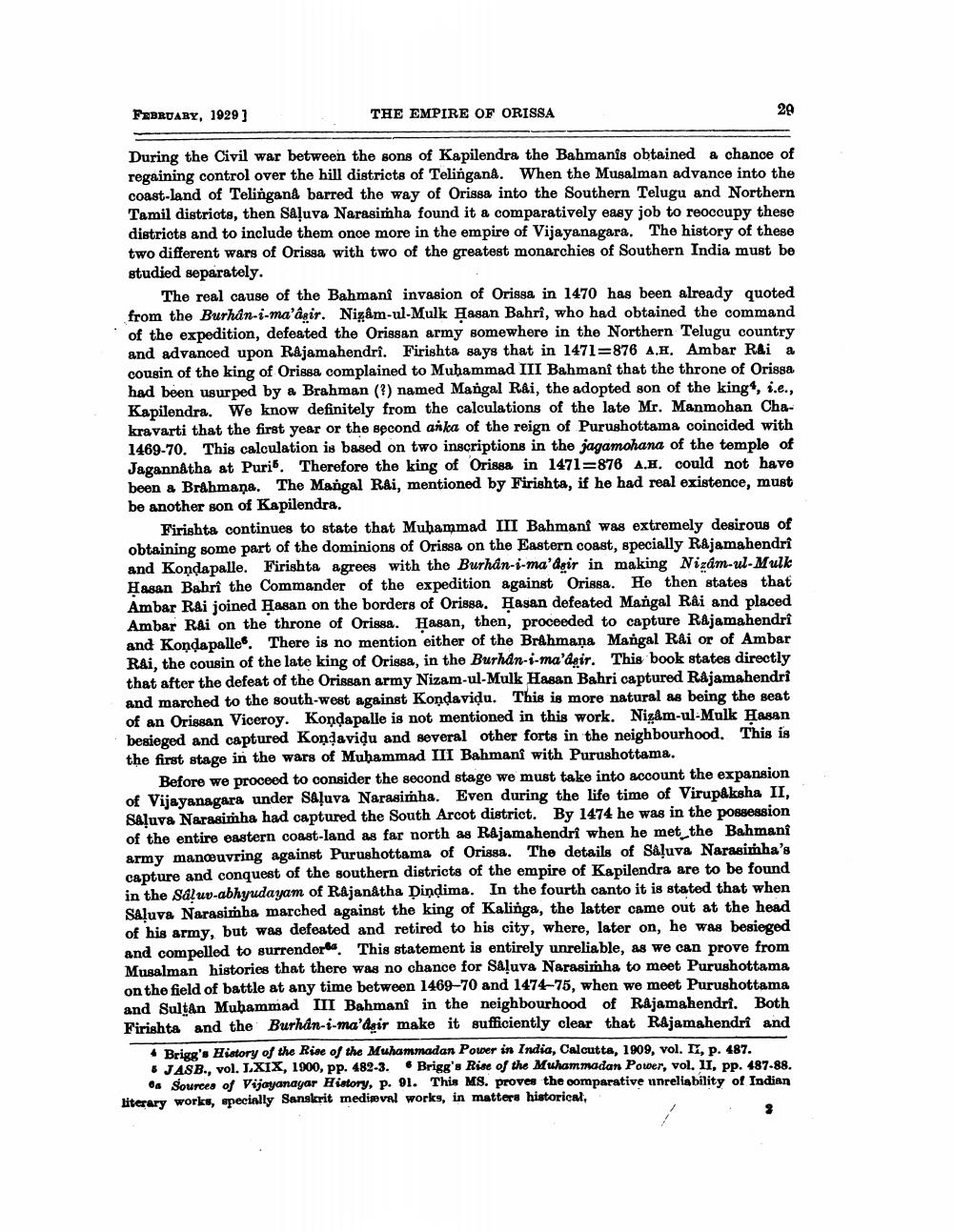________________
FEBRUARY, 1929 ]
THE EMPIRE OF ORISSA
During the Civil war between the sons of Kapilendra the Bahmanis obtained a chance of regaining control over the hill districts of Telingana. When the Musalman advance into the coast-land of Telingana barred the way of Orissa into the Southern Telugu and Northern Tamil distriots, then Saļuva Narasimha found it a comparatively easy job to reoccupy these districts and to include them once more in the empire of Vijayanagara. The history of these two different wars of Orissa with two of the greatest monarchies of Southern India must be studied separately.
The real cause of the Bahmani invasion of Orissa in 1470 has been already quoted from the Burhan-i-ma'âsir. Nizâm-ul-Mulk Hasan Bahri, who had obtained the command of the expedition, defeated the Orissan army somewhere in the Northern Telugu country and advanced upon Rajamahendri. Firishta says that in 1471=876 A.H. Ambar Rai a cougin of the king of Orissa complained to Muhammad III Bahmani that the throne of Orissa had been usurped by a Brahman (?) named Mangal Rai, the adopted son of the king4, i.e., Kapilendra. We know definitely from the calculations of the late Mr. Manmohan Chakravarti that the first year or the second anka of the reign of Purushottama coincided with 1469-70. This calculation is based on two inscriptions in the jagamohana of the temple of Jagannatha at Purib. Therefore the king of Orissa in 1471=876 A.H. could not have been a Brahmana. The Mangal Rai, mentioned by Firishta, if he had real existence, must be another son of Kapilendra.
Firishta continues to state that Muhammad III Bahmani was extremely desirous of obtaining some part of the dominions of Orissa on the Eastern coast, specially Rajamahendri and Kondapalle. Firishta agrees with the Burhan-z-ma'asir in making Nizâm-ul-Mulk Hagan Babri the Commander of the expedition against Orissa. He then states that Ambar Rai joined Hasan on the borders of Orissa. Hasan defeated Mangal Rai and placed Ambar Rai on the throne of Orissa. Hagan, then, proceeded to capture Rajamahendri and Kondapalle. There is no mention either of the Brahmana Mangal Rai or of Ambar Rai, the cousin of the late king of Orissa, in the Burhan-i-ma'asir. This book states directly that after the defeat of the Orissan army Nizam-ul-Mulk Hasan Bahri captured Rajamahendri and marched to the south-west against Kondavidu. This is more natural as being the seat of an Orissan Viceroy. Kondapalle is not mentioned in this work. Nizam-ul-Mulk Hasan besieged and captured Konavidu and several other forts in the neighbourhood. This is the first stage in the wars of Muhammad III Bahmani with Purushottama.
Before we proceed to consider the second stage we must take into account the expansion of Vijayanagara under Saluva Narasimha. Even during the life time of Virupaksha II, Saluva Narasimha had captured the South Arcot district. By 1474 he was in the possession of the entire eastern coast-land as far north as Rajamahendrî when he met the Bahmani army maneuvring against Purushottama of Orissa. The details of Saļuva Narasimha's capture and conquest of the southern districts of the empire of Kapilendra are to be found in the salud-abhyudayam of RAjanåtha Dindima. In the fourth canto it is stated that when SAļuva Narasimha marched against the king of Kalinga, the latter came out at the head of his army, but was defeated and retired to his city, where, later on, he was besieged and compelled to surrenderla. This statement is entirely unreliable, as we can prove from Musalman histories that there was no chance for Saļuva Narasimha to meet Purushottama on the field of battle at any time between 1469-70 and 1474-75, when we meet Purushottama and Sultan Muhammad III Bahman in the neighbourhood of Rajamahendri. Both Firights and the Burhan-i-ma'dgir make it sufficiently clear that Rajamahendrî and
4 Bring's History of the Rise of the Muhammadan Power in India, Calcutta, 1909, vol. II, p. 487. 8 JASB., vol. LXIX, 1900, pp. 482-3. Brigg's Rise of the Muhammadan Power, vol. II, pp. 487-88.
da sources of Vijayanagar History, p. 91. This MS. proves the comparative unreliability of Indian literary works, specially Sanskrit medieval works, in matters historical,




